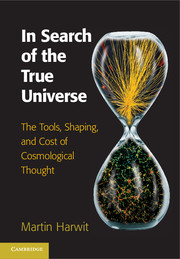Book contents
- Frontmatter
- Contents
- Preface
- Notes on Usage
- 1 The Nineteenth Century's Last Five Years
- Part I The Import of Theoretical Tools
- Part II A National Plan Shaping the Universe We Perceive
- Part III The Cost of Discerning the True Universe
- 14 Organization and Functioning of the Astronomical Community
- 15 Language and astrophysical Stability
- 16 An Economically Viable Astronomical Program
- Epilogue
- Appendix: Symbols, Glossary, Units and Their Ranges
- Index
- References
16 - An Economically Viable Astronomical Program
Published online by Cambridge University Press: 05 December 2013
- Frontmatter
- Contents
- Preface
- Notes on Usage
- 1 The Nineteenth Century's Last Five Years
- Part I The Import of Theoretical Tools
- Part II A National Plan Shaping the Universe We Perceive
- Part III The Cost of Discerning the True Universe
- 14 Organization and Functioning of the Astronomical Community
- 15 Language and astrophysical Stability
- 16 An Economically Viable Astronomical Program
- Epilogue
- Appendix: Symbols, Glossary, Units and Their Ranges
- Index
- References
Summary
A theme encountered throughout this book has been the resourceful approach of astronomers and astrophysicists of the twentieth century as they searched for new ways to advance our understanding of the Universe. By adopting the new atomic and ionic theories of Niels Bohr and Meghnad Saha, Henry Norris Russell and Cecilia Payne determined the abundances of the chemical elements in the Sun and stars. Willem de Sitter and Arthur Stanley Eddington taught us how Einstein's relativity theories could lead to new insights on an evolving Universe. And the nuclear theories of George Gamow, Hans Bethe, and Edwin Salpeter provided novel insight on the energy sources of stars and the origins of the chemical elements. Astronomical observers similarly adopted techniques developed by physicists and engineers to greatly expand the wavelength ranges across which the Cosmos might be studied. By adopting methods developed elsewhere, the cost of astronomy was kept low.
This enterprising spirit will stand us in good stead as we face a newer set of challenges posed by the global economic downturn of late 2008 that still persist today. Finding new ways to advance astronomy under these conditions will be important for solving the cosmological problems now to be overcome. Those efforts will undoubtedly take time, and will succeed best if we choose an appropriate economic approach aimed at assuring the long-term stability of our astronomical program.
- Type
- Chapter
- Information
- In Search of the True UniverseThe Tools, Shaping, and Cost of Cosmological Thought, pp. 350 - 366Publisher: Cambridge University PressPrint publication year: 2013



